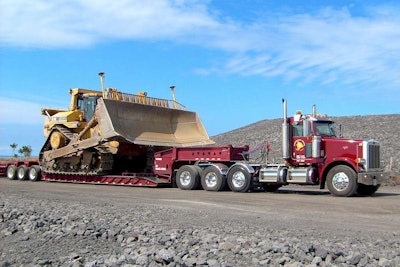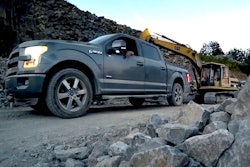
Contractors and heavy equipment haulers often ask the question, “What is the longest trailer or semitrailer I can use?” The answer—like for most questions regarding sizes and weights—is “That depends!”
The “length allowed” varies by state, by route, by the number of trailing units, whether the unit(s) is a trailer or a semitrailer, whether it is pulled by a straight truck or a truck-tractor, and by the kingpin to rear axle length.
For these reasons the answer is not only dependent on the variables, but due to the variables, arriving at the answer can be very confusing. This article will focus on just one set of variables—the kingpin to rear axle measurement when hauling heavy equipment on a semitrailer with a truck-tractor.
Some background first: To some carriers’ surprise, federal size and weight limits are not determined by the Federal Motor Carrier Safety Administration (FMCSA), but by the Federal Highway Administration (FHWA) in the Code of Federal Regulations (CFR), Title 23, Part 658. The purpose of the Part is “to identify a National Network of highways available to vehicles authorized by provisions of the Surface Transportation Assistance Act of 1982 (STAA) as amended, and to prescribe national policies that govern truck and bus size and weight.” Through this Act, the federal government set minimums on the National Network that the states must allow.
Before we continue, let’s get some important definitions out of the way:
- Tractor or Truck Tractor means the noncargo-carrying power unit that operates in combination with a semitrailer or trailer (23 CFR 658.5).
- Semitrailer means any motor vehicle, other than a pole trailer, that is designed to be drawn by another motor vehicle and is constructed so that some part of its weight rests upon the self-propelled towing motor vehicle (49 CFR 390.5).
- Kingpin to rear axle is measured from the kingpin to the center of the rear axle, if single, or to the center of a group of rear axles (23 CFR 658.19(h)(2)(i)(C))
Moving on here’s some good news: When the Surface Transportation Assistance Act of 1982 was enacted, it provided that “No state shall establish, maintain, or enforce any regulation of commerce which imposes a vehicle length limitation of less than forty-eight feet on the length of the semitrailer unit operating in a truck tractor-semitrailer combination… on any segment of the National System of Interstate and Defense Highways and those classes of qualifying Federal-aid Primary System highways…”
That means that 48-foot semitrailers, as a minimum, are allowed on any portion of the National Network when pulled by a truck-tractor. This includes flatbeds, lowboys, and step-trailers. While this meets the need for many heavy equipment haulers, what happens if a 53-foot trailer is required for the move?
For trailers over 48 feet, the rules get more complex. While the Act also grandfathered any “trailers or semitrailers of such dimensions as those that were in actual and lawful use” in any given state, the states did not have a standard allowed length. Almost half of the states already allowed at least 53-foot trailers, but the other half remained somewhere south of 53 feet.
Since that time, all states but Hawaii allow 53-foot trailers; however, many states that had a 48-foot maximum added a kingpin to rear axle distance limit when trailers over 48 feet are used (see below). States regulate this distance to help control the wheelbase and turning radius of the combination.
Consequences
While you’re required to meet the kingpin limits in the states of travel, you still also need to consider legal weight. Many semitrailers greater than 48 feet in length have adjustable sliding axle groups. These sliding axles allow for the balancing of axle weights by adjusting the fulcrum location, which is done to either shorten the kingpin to rear axle measurement or to facilitate the loading of heavy equipment. If the rear axle group is moved forward to meet a state’s kingpin to rear axle requirements, the net result of moving the fulcrum forward will be to reduce the weight on the drives and increase the weight on the trailer group. That’s fine if the trailer is loaded heavier on the front than on the rear. However, if the equipment is loaded so the aft is heavier, it may be difficult to “axle out” the group without adjusting the location of the loaded equipment.
State-by-state kingpin to rear axle limits
So… what do the state kingpin to rear axle limits look like? Below we’ve compiled information for all of the states that establish such a limit.
It’s important to pay close attention to which distance applies—in some states you’ll be measuring from the kingpin to the center of the rear axle but in other states you will measure from the kingpin to the center of the rear axle group.
Alabama — 41 feet to the rearmost axle or a point midway between the two rear axles (only applies to semitrailers greater than 53 feet 6 inches).
California — If semitrailer has two or more axles – 40 feet to rearmost axle, 38 feet to rear axle if semitrailer has one axle.
Connecticut — 43 feet between kingpin and center of rearmost axle with wheels in contact with the road surface – allowed on U.S. and CT Routes 1 to 399, 450, 476, 508, 693, and 695, and on Interstates and designated routes only.
Florida — 41 feet between kingpin and the center of the rear axle or rear group of axles on all roads except roads on the State Highway System that are restricted by the DOT or roads restricted by local authorities.
Illinois — On Class I and II highways, 45 feet 6 inches to the center of the rear axle (applies to trailers greater than 48 feet). On Class III and other non-designated state highways, 42 feet, 6 inches is the maximum allowed to the center of the rear axle.
Indiana — 43 feet to the rearmost axle of the semitrailer (only applies to semitrailers longer than 48 feet, 6 inches).
Maine — 43 feet to the center of the rearmost axle; however, the overall length is not to exceed 74 feet on non-National Network highways.
Maryland — 41 feet to the center of the rear tandem axles—allowed on Interstates and designated routes only.
Michigan — 37.5 to 40.5 feet (±0.5 foot) to the center of the rear axle or the center of the rear axle assembly—allowed on Interstates and designated highways only (applies to semitrailers longer than 50 feet). Tractor and lowboy semitrailer combinations have no overall length if lowboy does not exceed 59 feet, the kingpin to rear axle does not exceed 55 feet, and there are no more than 4 axles on the lowboy.
Minnesota — 43 feet to the centerline of the rear axle group.
New Hampshire — 41 feet to the centerline of the rear axle or to the midpoint of a tandem axle of the semitrailer—allowed on Interstates and designated highways only.
New Jersey — 41 feet to the centerline of the rear axle or rear axle group—allowed on Interstates and designated highways only.
New York — 43 feet to the centerline of the rear axle—allowed on Interstates and designated highways only.
New York City — trailers over 48 feet up to 53 feet only allowed on I-95 between I-287 and I-295, on I-295 between I-295 and I-495, and on I-495 between I-95 and the Nassau-Queens county line; kingpin to center of rear axle or rear axle group limited to 43 feet.
North Carolina — 41 feet to the rearmost axle or to a point midway between the two rear axles—allowed on Interstates and designated highways only.
Pennsylvania — 41 feet to the centerline of the rear axle or rear axle group.
Rhode Island — 41 feet to the center of the rear axle—allowed on Interstates and designated highways only.
South Carolina — 41 feet to the center of the rear axle assembly or to the center of the tandem axle assembly.
Tennessee — 41 feet to the rearmost axle or to a point midway between the two rear axles.
Vermont — 41 feet to the center of the rearmost axle.
Virginia — 41 feet to the rearmost axle or to a point midway between the rear tandem axles.
West Virginia — 37 feet from the rear axle of the truck-tractor and the front axle of the semitrailer—allowed on interstates and designated highways only.
Wisconsin — 43 feet to the center of the rearmost axle or to a point midway between tandem axles—allowed on interstates and designated highways and certain state trunk highways only.













